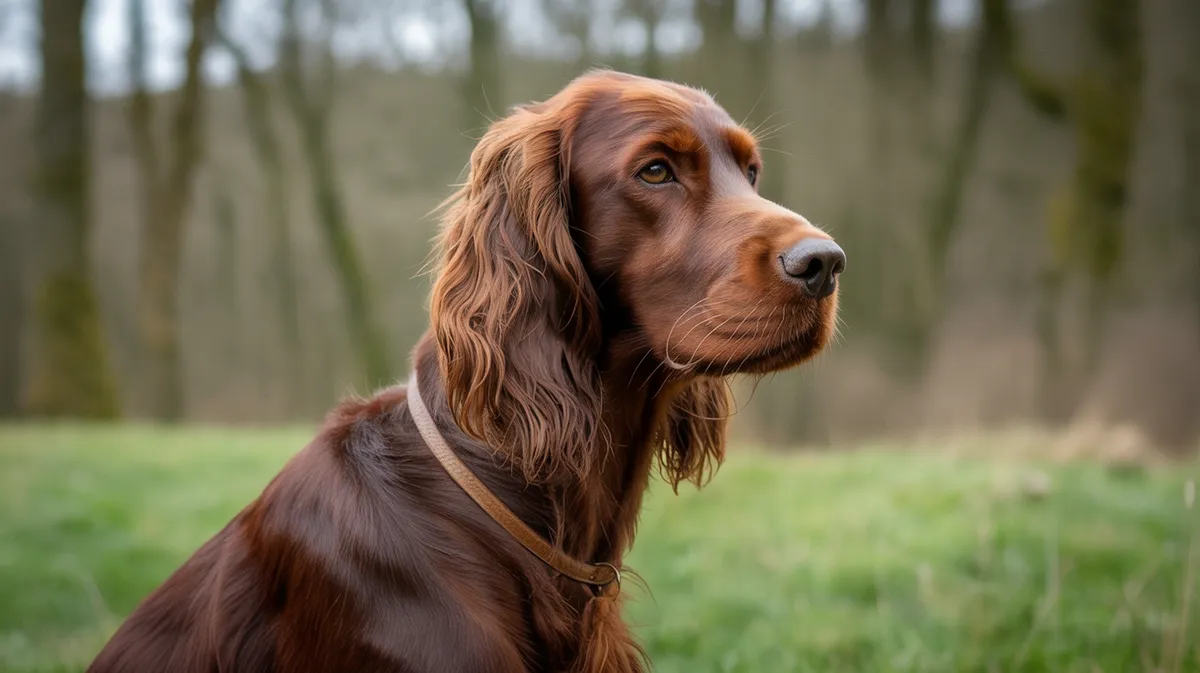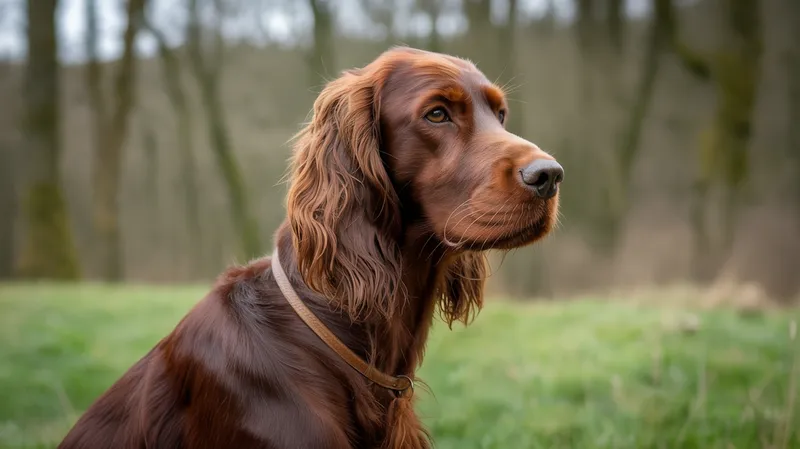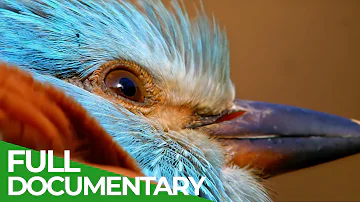
Irish Setter
Canis lupus familiaris

Meet the Irish Setter
The Irish Setter is a striking and athletic breed of domestic dog known for its distinctive silky, mahogany-red coat and elegant build. Originally bred in Ireland as a gundog for hunting game birds, this setter is prized for its stamina, speed, and keen sense of smell. Irish Setters are renowned for their friendly, outgoing temperament, making them popular family companions as well as skilled working dogs. They are highly energetic and thrive in active households where they can receive plenty of exercise and mental stimulation.
Classification
Mammal
Habitat
Domesticated; originally grasslands and forests
Diet
Omnivore
Lifespan
12-15 years
Conservation
Least Concern
Weight
25-32 kg (55-70 lbs)
📖Fascinating Facts
High Energy
Irish Setters are extremely energetic and need plenty of daily exercise to stay happy and healthy.
Excellent Scent
Bred as bird dogs, Irish Setters have a highly developed sense of smell, making them exceptional scent-tracking hunters.
Sociable Nature
They are known for their loving, friendly disposition and typically get along well with children and other pets.
📋Detailed Description
The Irish Setter is a large, athletic gundog breed characterized by its deep chest, long legs, and a graceful, streamlined silhouette. Adult males typically stand 58–67 cm (23–26.5 in) at the shoulder and weigh 27–32 kg (60–70 lbs), with females slightly smaller. The breed's most distinctive feature is its lustrous, feathered mahogany or chestnut-red coat, which is fine, straight, and requires regular grooming to maintain. Irish Setters have a long, narrow head, pronounced stop, and dark almond-shaped eyes that convey a lively, intelligent expression. Their ears are set low and hang close to the head, covered in silky hair. Anatomically, they possess a deep ribcage and strong hindquarters, adaptations that support their remarkable stamina and speed in the field. Behaviorally, Irish Setters are highly energetic, playful, and affectionate, often forming strong bonds with family members and displaying a gentle disposition toward children. They are intelligent and eager to please but can be independent and sometimes stubborn, requiring consistent, positive training. The breed is known for its keen sense of smell and ability to locate and 'set'—or freeze and point—game birds, a trait honed through generations of selective breeding. In modern settings, Irish Setters excel in various canine sports, including agility, obedience, and field trials, and are valued as both working dogs and loyal companions.
💡 Did you know?
Despite their aristocratic appearance, Irish Setters are known for their clownish, mischievous sense of humor and love to entertain their families.
🔬Research & Sources
Wikipedia Summary
The Irish Setter is a setter, a breed of gundog, and family dog originating in Ireland. The term Irish Setter is commonly used to encompass the show-bred dog recognised by the American Kennel Club as well as the field-bred Red Setter recognised by the Field Dog Stud Book.
Last Modified: 4/4/2025
🎭Behavior & Social Structure
Irish Setters are renowned for their exuberant, friendly temperament and high activity levels. They thrive on regular exercise and mental stimulation, often requiring at least 1–2 hours of vigorous activity daily. In hunting contexts, they display a characteristic 'setting' behavior: upon detecting game birds, they freeze in a pointing stance, indicating the prey's location to the hunter. Their hunting style is methodical yet swift, covering large areas with a fluid, ground-covering gait. Socially, Irish Setters are highly people-oriented and generally get along well with other dogs and animals, though their strong prey drive may prompt chasing of small wildlife. They are known for their playful, sometimes mischievous nature, and can become bored or destructive if under-stimulated. Daily routines often include interactive play, scent games, and social engagement, as they are sensitive to isolation and thrive in active, attentive households.
👶Reproduction & Life Cycle
Irish Setters reach sexual maturity around 12–18 months of age. The breed typically exhibits biannual estrus cycles in females, with mating most commonly occurring in spring and autumn. Gestation lasts approximately 63 days, after which litters of 6–9 puppies are common, though larger litters are possible. Breeders often select for both temperament and working ability, especially in field lines. Parental care is primarily provided by the dam, who nurses and grooms the puppies for the first 3–4 weeks, after which weaning begins. Socialization is critical during the early weeks, as puppies are highly receptive to environmental stimuli and human interaction. Responsible breeders emphasize early neurological stimulation and exposure to varied experiences to promote stable temperaments.
🛡️Adaptations & Survival
The Irish Setter's long, muscular limbs and deep chest are evolutionary adaptations for endurance and speed, enabling them to traverse rough terrain during extended hunts. Their fine, feathered coat provides protection from brush and inclement weather while remaining lightweight enough to prevent overheating. The breed's acute olfactory senses are a result of selective breeding for scent detection, crucial for locating hidden game birds. Their 'setting' behavior—freezing in a low crouch upon detecting prey—is a specialized adaptation that minimizes disturbance and signals the hunter. Socially, their cooperative and trainable nature reflects selection for dogs that work closely with humans and other dogs in the field.
🎨Cultural Significance
The Irish Setter holds a prominent place in Irish heritage and is celebrated as a national symbol of Ireland. Historically, the breed was favored by Irish nobility and gamekeepers for its hunting prowess and striking appearance. Irish Setters have appeared in literature, art, and popular culture, often symbolizing loyalty, vitality, and elegance. The breed's popularity surged in the 19th and 20th centuries, especially in the United States and the United Kingdom, where it became a sought-after companion and show dog. The Irish Setter is also featured in various canine organizations' logos and has been the subject of several books and films.
🔬Recent Research & Discoveries
Recent genetic studies have explored the divergence between show-bred and field-bred Irish Setters, revealing significant differences in morphology, behavior, and working ability. Research into breed-specific health issues, such as PRA and bloat, has led to the development of genetic screening tests and improved breeding protocols. Behavioral studies highlight the breed's high trainability and sensitivity to positive reinforcement, while ongoing research in canine cognition underscores their problem-solving abilities and social intelligence. Conservation of working traits is a focus among field enthusiasts, with efforts to maintain the breed's original hunting capabilities through selective breeding and field trials.
🎥Wildlife Videos

Wild Asia - Fantastic Creatures of Tian Shan | Free Documentary Nature
Kingdom of the Bears: Masters of Wilderness | Free Documentary Nature Kingdom of the Bears: Asia's Brown Bear Mountains ...
Free Documentary - Nature

An Irish Setter Film
See a working Irish Setter hunt his native soil.Filmed on the Comeragh Mountains Waterford/Tipperary.Support my channel at ...
Gundog & Fly

The Unique Wildlife of Brazil’s Rainforest
Explore the incredible biodiversity and unique ecosystems of Brazil's Mata Atlântica and other regions. The show delves into the ...
Real Wild

Secrets of the Outback | Wild Australia in 4K | Wildlife Nature Documentary
To many, Australia's Outback seems barren and inhospitable — a vast, sun-scorched wilderness with little life to offer. But look ...
Into the Wild Films

The Incredible Scottish Highlands (4K Documentary) | Our World
Narrated by Ewan McGregor, this landmark series gives a beautiful portrait of life in the Scottish Highlands, following the wildlife ...
Our World

THE SWISS ALPS | Secrets of the Apex Hunters | Animal documentary
Welcome to the majestic Swiss Alps, a breathtaking wilderness that's home to some of the most extraordinary apex predators on ...
WILD NATURE - Nature animal documentary
🌍Habitat Information
The Irish Setter typically inhabits Domesticated; originally grasslands and forests environments. Irish Setters have adapted to their environments with specialized features and behaviors.
Primary Habitat:
Domesticated; originally grasslands and forests
More detailed habitat information will be available soon.
🛡️Conservation Status
The Irish Setter is currently classified as Least Concern. Conservation efforts are crucial for preserving this species for future generations.
Common Threats:
- 🏠Habitat loss and fragmentation
- 🌡️Climate change impacts
- 🎯Hunting and poaching
- 🏭Human-wildlife conflict
⚠️Threats & Conservation Challenges
As a domesticated breed, Irish Setters are not threatened in the wild, but they face several challenges related to health and population management. The breed is predisposed to certain hereditary conditions, including hip dysplasia, progressive retinal atrophy (PRA), and bloat (gastric dilatation-volvulus). Overbreeding and prioritization of appearance over function in show lines have led to some loss of working traits and increased incidence of genetic disorders. Responsible breeding practices and health screening are vital to maintaining genetic diversity and breed health. While overall population numbers are stable, the division between show and field lines has led to concerns about preserving the breed's original working abilities.
🔬Scientific Classification
Scientific Name
Canis lupus familiaris
Classification Hierarchy
🔍 About Taxonomic Classification
Taxonomic classification is a hierarchical system used by scientists to classify and organize living organisms based on shared characteristics and evolutionary relationships.
The system moves from broad categories (Kingdom) to increasingly specific ones, with each animal's scientific name typically consisting of its Genus and species.
📝Community Notes
Share your observations and insights about the Irish Setter with our community of wildlife enthusiasts.
Join Our Community
Sign in to share your observations and connect with fellow wildlife enthusiasts.
Sign In to ContributeNo community notes yet
Be the first to share your observations about the Irish Setter!
Explore Irish Setter
Select a tab above to learn more about this amazing animal.
📸Photo Gallery
No photos available for this animal yet.
🌟Discover More Wildlife
Continue your journey of discovery with more fascinating animals from our database
